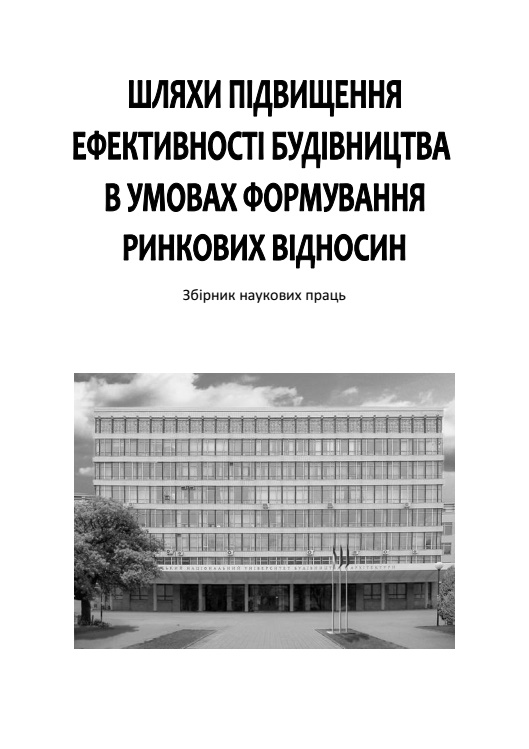Formation of marketing price policy of gas concrete manufacturers in regional markets of Ukraine using cluster analysis
DOI:
https://doi.org/10.32347/2707-501x.2021.47(2).72-85Keywords:
aerated concrete, market, region, import, price, construction volumes, real estate price, demand, supply, oligopolyAbstract
The main indicators of the situation of regional markets of aerated concrete are described taking into account the radius of delivery of construction material from the manufacturer. The level of supply of aerated concrete in regional markets of Ukraine is estimated territorial distribution of imports. The mutual influence of factors and indicators of conjuncture of regional markets of aerated concrete is analyzed, the key factors of formation of the retail price are defined.
Peculiarities of pricing for construction materials and products in the conditions of oligopoly are characterized. The level of demand for aerated concrete in each region of Ukraine is estimated on the basis of data on regional construction volumes, regional real estate prices and regional price of aerated concrete. The relationship between the supply of aerated concrete in the regions of Ukraine and the level of prices for it is described. Based on the comparison of relative regional levels of demand and supply, the balance of the aerated concrete market in each region of Ukraine is determined. It is proved that the aerated concrete market in Ukraine has a clear regional segmentation, and pricing in regional aerated concrete markets corresponds to the Walras model, according to which price is not a function of demand (as in Marshall's theory of market equilibrium), but its factor. Regional clusters of the aerated concrete market of Ukraine have been formed according to the indicators of the level of prices for aerated concrete. Given their quantitative and qualitative assessment. It is proved that the production capacities of domestic producers together with the capacities of importers are sufficient to meet the demand for aerated concrete in Ukraine, but in some industrialized regions there is a shortage of aerated concrete. It is proposed to carry out comprehensive regulation of pricing in regional markets of aerated concrete of Ukraine by producers through the formation of effective marketing pricing policy, as well as identified areas of regulation of pricing of aerated concrete products in accordance with regional (regional) aerated concrete markets in Ukraine, which should take into account key demand factors. and offers in the region.
References
Бєлєнкова О.Ю. Кластерний аналіз ринку як аналітична компонента вибору конкурентної політики девелопера. Актуальні проблеми економіки. 2019. № 6 (216). С. 141-158.
Деркаченко В.Н. Прогнозирование и кластерный анализ развития регионального рынка жилой недвижимости / В. Н. Деркаченко // Научно-методический электронный журнал «Концепт». – 2014. – Т. 20. – С. 11–15: [Електрон. ресурс]. – Режим доступу: http://e-koncept.ru/2014/54262.htm.
Динаміка цін на квартири в Україні у 2019 році: [Електрон. ресурс]. – Режим доступу: https://krysha.ua/tseny.
Ціни на основні будівельні матеріали у регіонах України станом на 01.12.2019 року: інформація ТОВ «Інпроект»: [Електрон. ресурс]. – Режим доступу: https://www.inproekt.kiev.ua/Files/01-12-2019.zip.
Кавун С.В. Використання кластерного аналізу для вирішення задачі оптимізації платежів за використання природних ресурсів на підприємствах в галузі будівельних матеріалів / С.В. Кавун, О.С. Ридаш, О.Г. Зима // Системи обробки інформації, 2010, випуск 5 (86). – C. 216-220: [Електрон. ресурс]. – Режим доступу: http://www.hups.mil.gov.ua/periodic-app/article/7648/soi_2010_5_53.pdf.
Сиротін О.В. Ринок автоклавного газобетону України в 2017 р: презентація Всеукраїнської асоціації виробників автоклавного газобетону / О.В. Сиротін - [Електрон. ресурс]. – Режим доступу: https://www.slideshare.net/AEROC_Vinnitsa/2017-105999433.
Скрипник О.В. Аналіз ступеня монополізації ринку та географічного розташування виробників газобетону в Україні [Текст] / О.В. Скрипник // Шляхи підвищення ефективності будівництва в умовах формування ринкових відносин. – 2018. – № 37. – С. 98-107.
Skrypnyk, O. (2021). Сluster analysis of regional markets of autoclave aerated concrete in Ukraine by price level and supply level indicators. Economics, Finance and Management Review, (1), 12-22. https://doi.org/10.36690/2674-5208-2021-1-12.
Рішення Державного комітету України з будівництва та архітектури від 16.05.2003 р. N 41 «Про проект Державної програми "Розвиток виробництва ніздрюватобетонних виробів та їх використання в масовому будівництві України на 2003-2011 роки». - [Електрон. ресурс]. – Режим доступу: https://zakon.rada.gov.ua/rada/show/va041509-03#Text.
Обсяги будівництва за регіонами України у 2019 році: інформація Державної служби статистики України. - [Електрон. ресурс]. – Режим доступу: http://www.ukrstat.gov.ua/operativ/operativ2020/bud/ovb_reg/xls/ovb_regm_2019.xls
Задоя А.О. Мікроекономіка: Курс лекцій та вправи: Навч. посіб. / А.О. Задоя. - К.: Знання, 2002. - 211 с.
Захарченко П.В. Довідник по ринку матеріалів для внутрішнього облаштування та оздоблення приміщень (за даними 2019 р.) П.В. Захарченко, Гавриш О.М., Соха В.Г., Алавердян Л.М. та інші. - К.: КНУБА, 2020. – 263 с.
Downloads
Published
How to Cite
Issue
Section
License

This work is licensed under a Creative Commons Attribution 4.0 International License.
Authors who publish with this journal agree to the following terms:
- Authors retain copyright and grant the journal right of first publication with the work simultaneously licensed under a Creative Commons Attribution License that allows others to share the work with an acknowledgement of the work's authorship and initial publication in this journal.
- Authors are able to enter into separate, additional contractual arrangements for the non-exclusive distribution of the journal's published version of the work (e.g., post it to an institutional repository or publish it in a book), with an acknowledgement of its initial publication in this journal.
- Authors are permitted and encouraged to post their work online (e.g., in institutional repositories or on their website) prior to and during the submission process, as it can lead to productive exchanges, as well as earlier and greater citation of published work (See The Effect of Open Access).

